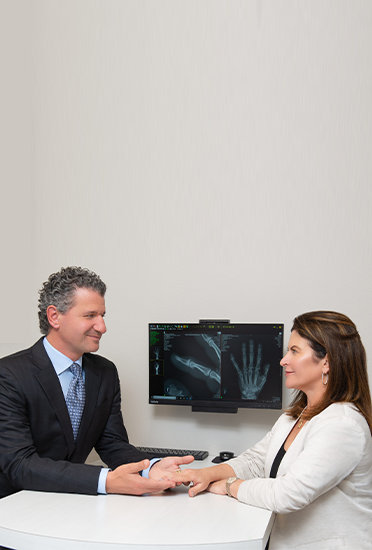Turns out, I’m hip to a new trend.
A titanium-alloy spike is now part of my femur.
The five-inch-long forged hunk of metal came off the assembly line in a Memphis, Tennessee, factory in December 2017. Manufactured by a company called Smith and Nephew, the component is a model called Anthology. It’s one of four pieces that comprise my artificial hip.
That part, called a stem, joined my body in April of last year, at NYU Langone Orthopedic Hospital in Manhattan. A surgeon cut off the boney ball at the top of my femur, reamed out the socket in the part of the pelvis where the hip joint is located (anatomically, the “acetabulum”), and installed that stem, plus three other pieces. Later that same day, I left the hospital and went home with those components as new members of the body I was born with in 1978.
I’m one of hundreds of thousands of people in the U.S. who receive a total hip replacement each year. As a young person—I was 39 when it was installed—I’m an outlier, but also somewhat hip to a trend. The age of artificial hip recipients is falling: In 2000, the average age was just over 66; in 2014, it was 64.9. The fastest growing group? It isn’t retirees, but rather people ages 55 to 64, says Matt Sloan, a surgical resident at the University of Pennsylvania medical school who has researched the procedure’s demographic trends.
I wanted a new hip because I’d been in pain for years. In 2010, when I was in my early 30s, I tore my labrum, which is ring-like cartilage in the joint. A painful arthroscopic surgery in 2011 to repair it failed to make my hip better, and I needed a “revision” surgery. In 2014, a doctor did everything he could to repair the joint, and gave me a tissue graft from a cadaver to fix my re-torn labrum. Ultimately, that operation also failed. I needed a new hip. It was the weakest point in my body—an arthritic joint that had to go.
Over the decades, the materials in artificial hips have improved enough that doctors are now confident putting them in younger patients like me. “Surgeons, in the past, were unwilling to do a total hip replacement on them, because they thought they might be starting a sequence of multiple operations,” says Dr. Lawrence Dorr, a professor of clinical orthopaedic surgery at the University of Southern California Keck School of Medicine. Now, “they know they can do a hip replacement, and if it’s very well done, there isn’t any reason it can’t go 30 years.”
A series of failures, breakthroughs, and incremental improvements throughout the 20th century have led to a prosthesis so refined that bone can literally grow into it.
Here’s how it works: The four parts of a modern artificial hip replace a big ball and socket joint. During the operation, after the surgeon cuts off that ball at the top of the femur—the thigh bone, if you’re singing along—they insert a titanium stem inside the hollowed-out bone, with a portion of it still protruding. Then, a ceramic head (the new ball), attaches to the top of the stem; mine was made by German company Caramtec, and has a pinkish hue. On the acetabular side, a titanium-alloy shell shaped like a hemispheric cup press-fits into the reamed-out socket, and then a durable plastic (technically, cross-linked ultra-high-molecular-weight polyethylene) liner fits inside that metal cup.

A prosthetic hip replaces the natural joint that’s become wracked by arthritis.
Mayo Clinic
So that the metal can join with my skeleton, part of the stem and shell have a coating of a substance called commercially-pure titanium. Bone can fuze with this porous layer, no cement needed, joining the natural with the artificial. “Bone looks at this surface and kinda sees itself,” Dorr, who’s replaced about 7,000 hips and 5,000 knees, explains. A few weeks post-op, immature bone will have already started growing into the metal. “I never figured out why bone is so dumb,” Dorr lightheartedly says. Grow into the titanium? Sure, why not.
Read full article HERE.








